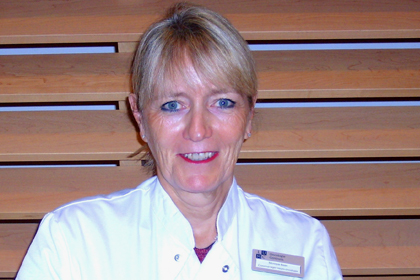The fastest way to encourage joint decision-making is with the Brightfish PROMs dashboards
Interview with Monique Baas, Advisor of Value-Driven Care and Nurse/Case Manager at Leiden University Medical Center (LUMC)
To improve the quality of their (individual) patient care, LUMC uses Brightfish’s PROMs dashboard. Monique Baas, advisor of value-driven care, nurse and case manager, shares her view on the approach to, and the future plans for PROMs dashboards at LUMC.

What is the added value for you in measuring questionnaires completed by patients?
It is essential to know how the patient experiences their treatment and their well-being. Suppose a patient scores a ’10’ if they can climb the stairs independently and a ‘5’ if they can only manage half of the steps. Does that mean in practice that their quality of life is any less? Perhaps that score of ‘5’ is the maximum that can reasonably be achieved, resulting in a 100% happy patient. How much inconvenience do you experience yourself, and how do you experience your life as it is now? You don’t get these answers from clinical outcomes, but they certainly influence the treatment plan.

We display the results of the PROMs in the Brightfish dashboard. We have used Brightfish for the thyroid carcinoma and pituitary adenoma care teams for some time. We are now expanding this to the other care teams as well. We work with a Brightfish dashboard in our EHR system. Questionnaires can be sent to patients via email at fixed times (four times a year). The dashboard illustrates the outcomes clearly: arrows and colours show how the patient is doing compared to the previous measurement(s) in table or graph form. If desired, you can see more details, for example, how the patient answered a specific question.
How do you use the Brightfish dashboard?
The physician or carer can review the data before and during a consultation. During the consultation, the healthcare provider and the patient look at the values together and discuss them in more detail does the patient recognise themselves in the values recorded, and do they have any questions about them? They might relate to adjusting the medication and the options to do so, or how a patient wants to continue the treatment. By comparing clinical data and PROMs and discussing these with the patient, we engage them in creating the appropriate treatment plan: making decisions together based on outcome information.
Another way to use the dashboard is at an aggregate level. We do not yet have enough data to compare the individual patient with others with the same condition (‘patients like me’). But with a dashboard that displays data from all patients at the exact measurement moment, we can certainly have a sense of a trajectory. By providing insight into group data, it is also possible to formulate improvement goals and improve the quality of our care for the entire patient population. We can quickly request the raw data and then analyse it.
Which caregiver provides that feedback varies by the care team. We often see that the nurse plays an essential role in this. For patients, contact with a nurse is relatively easy: usually, nurses have more time than doctors to discuss patient health outcomes.
You are a nurse yourself. To what extent is that experience helpful in combining your role on the value-driven care implementation team?
I would like to emphasise that the multidisciplinary aspect is crucial to value-driven care thinking, but in the practical organisation of care, the nursing perspective really helps.
For example, a quality manager probably approaches PROMs more research-oriented, but for use in practice, you need a medical or nursing view. Someone who looks not just at the disease but at patient as a person and who knows the care process (and the care landscape) well. That’s what nurses are good at!
Monique Baas, LUMC
For example, for the patient population in my neuro-oncology department, we recently set up PROMs in Brightfish. A standard measurement pathway isn’t practical for those patients because many of them deviate from a standard care pathway and participate in all sorts of studies. You don’t want patients with a brain disorder to fill in a questionnaire too often, so you want to organise a custom PROMs process for everyone. We strive to reuse data as much as possible, which also helps the patient.
What are the reactions to the dashboard?
Of course, it takes some getting used to for everyone, and it does generate some resistance from time to time. But once teams start using PROMs actively, they become enthusiastic. They like that they can interpret complaints based on PROMs and show patients how they are doing compared to previous consultations. As a result, carers have been able to offer patients more tailored support in the form of an educational program, have been able to make more correct referrals, and fine-tune medication. One physician who works a lot with it told me that she likes the use for her outpatient planning. Now she can prepare for conversations in advance and assess whether she needs to stick strictly to the scheduled time for each patient or whether she can move around a bit. In addition, if you don’t get a good idea of what the patient’s complaints are, you can do a different PROM measurement in the interim. And then it turns out there are underlying mood problems, for example.
Patients also respond positively. They can fill in the questionnaire quickly via computer, laptop, or smartphone. By completing the questionnaire, they gain more insight into their situation and discuss it with the healthcare provider. This way, they can help co-create the agenda for the consultation. In addition, we get feedback from patients that they like to fill in the questionnaire to know how they are doing. And a patient can take a printout of the PROMs to an external practitioner to show how they have improved.
What else do you want to achieve with the dashboard?
We still have a lot of wishes. As we are still learning what exactly can be done with the dashboard, we think it is too early to allow patients to view the dashboard entirely independently. We don’t want patients to be confronted with things they don’t understand and therefore have unnecessary worries. But that independent use is certainly a wish.
We also hope to start using Computer Adaptive Testing, a questionnaire technique that adapts to the patient’s answers. In that way, you achieve what you want to know with fewer questions; back to the example of stair climbing. For example, if the question is “Can you climb ten steps?” and the patient’s answer is “No,” then the follow-up question about being able to climb twenty steps is unnecessary.
Finally, it would be nice to run PROMs throughout the hospital at set times; that becomes just as natural as, say, taking blood samples. That way, the healthcare provider would also have patient-reported data ready to use when making decisions together. We are not there yet, but we are already delighted with the start we have made.
The original article in Dutch can be found here.
Would you also like to revolutionise patient‑centred care?
Request a demo
Please fill in the form below, and one of our employees will contact you as soon as possible.